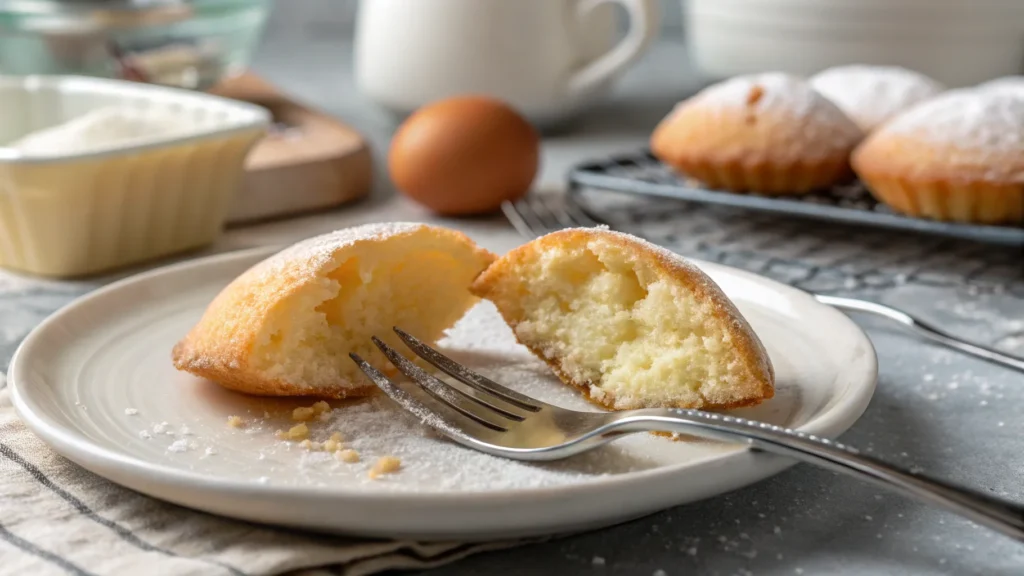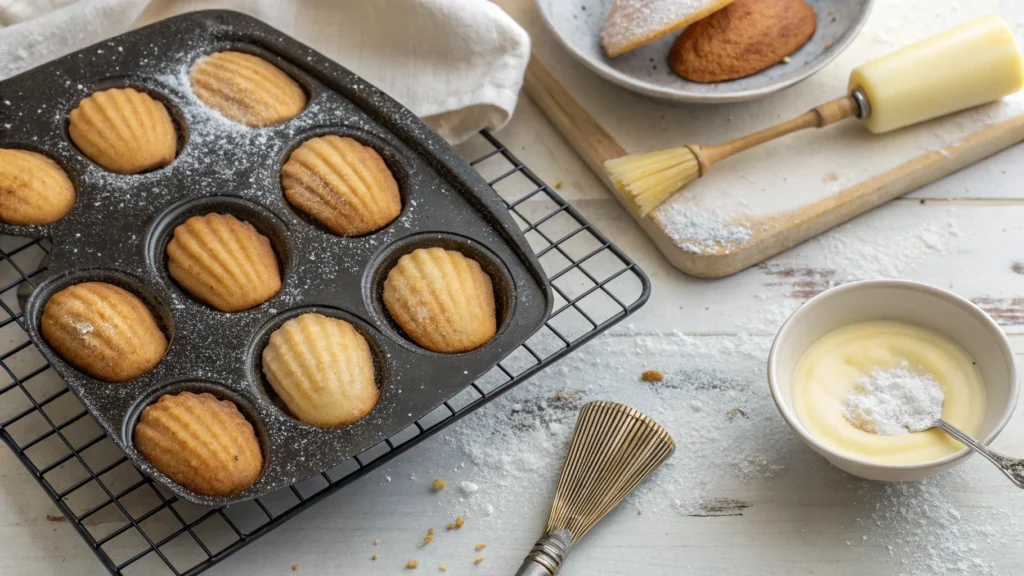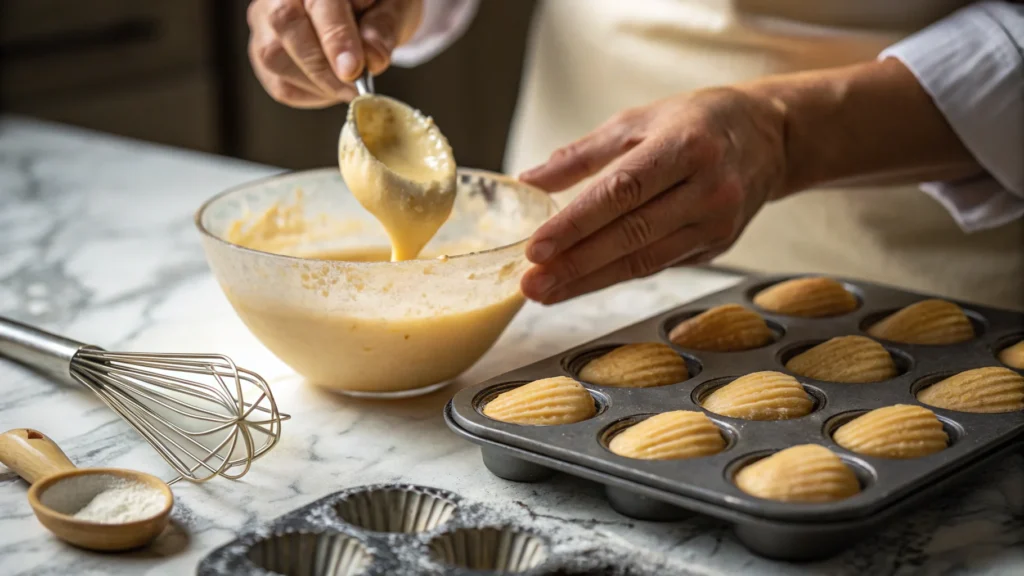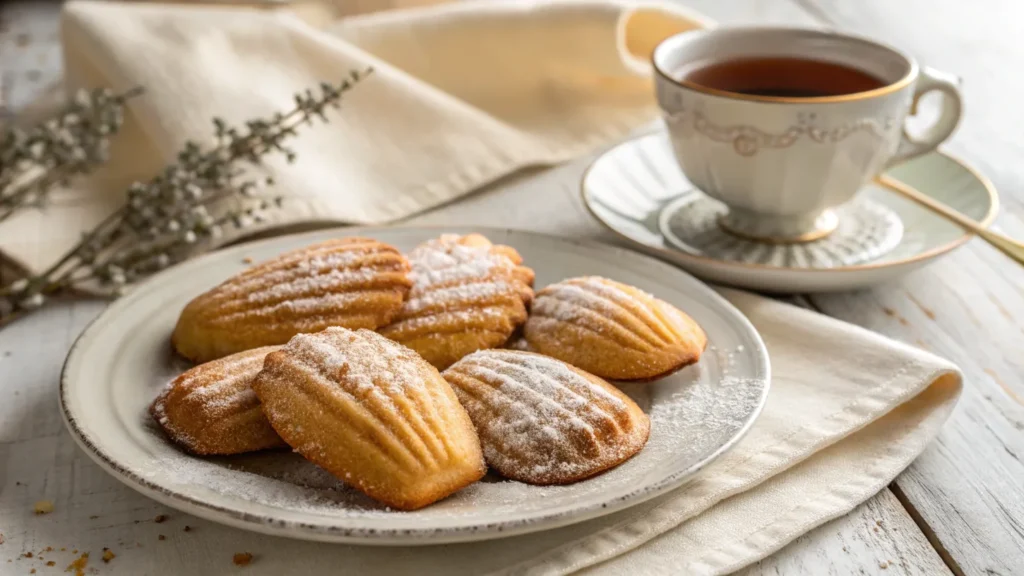Madeleine cookies, with their delicate texture, unique shape, and rich history, are beloved by many for their perfect combination of flavors and textures. Whether enjoyed during a French afternoon tea or as a comforting snack, these shell-shaped treats capture both hearts and taste buds. In this article, we will explore the elements that make madeleine cookies so irresistible, from their French origins to the ideal blend of ingredients.
Table of Contents

Why Are Madeleine Cookies So Good? Exploring Their Unique Appeal
People around the world love Madeleine cookies for their delicate flavor, unique texture, and rich history. Their light, airy texture, created by a careful blend of simple ingredients like flour, butter, eggs, and sugar, results in a moist, tender cookie with a slightly crisp exterior. The perfect balance of sweetness and subtle buttery flavor makes them a delightful snack at any time of day.
For a twist on this classic, explore how to keep Madeleines moist to maintain their freshness and texture.
The Origin of Madeleine Cookies: Why Are Madeleines So Tasty?
Why Are Madeleine Cookies So Good? Tracing Their French Heritage
Madeleine cookies have deep roots in French culture and history. People traditionally link the small, shell-shaped pastries to the region of Lorraine in northeastern France. According to popular legend, a young girl named Madeleine Paulmier first made the cookies and served them to King Louis XV in the 18th century. The king, impressed by the delicate treats, asked for the recipe, which began their journey into French culinary tradition.
For an in-depth comparison, check out the difference between Financiers and Madeleines to understand how these pastries stand apart.
A Brief History of Madeleine Recipes
The origins of madeleine cookies are unclear, but the earliest known recipe dates back to the late 18th century. Over time, bakers have adapted the recipe, incorporating regional influences and new techniques. Traditionally made with eggs, butter, flour, and sugar, with added lemon zest or vanilla, madeleine recipes have evolved to include variations like chocolate-dipped, lemon-infused, and gluten-free versions, while still maintaining their light texture and delicate flavor.
Why Are Madeleine Cookies So Popular Worldwide? The Global Appeal of Madeleines
The madeleine rose to global fame due to its association with French culture. As French cuisine gained international recognition in the 19th and 20th centuries, people introduced madeleine cookies to various parts of the world. Writers, such as Marcel Proust in Remembrance of Things Past, included them in literary works, further cementing their place in global culture.
The Unique Shape of Madeleine Cookies: How the Shell Shape Enhances Flavor
Why Are Madeleines So Good? The Influence of Their Shell Shape on Texture
The iconic shell shape of the madeleine plays a significant role in why the cookies taste so good. The design is not just for aesthetics – it influences the texture and flavor. The shallow, curved mold creates a golden-brown exterior while maintaining a moist, soft interior. This design helps the cookies cook evenly, producing the delicate texture that makes madeleines so irresistible.
When baking, discover the best substitutes for Madeleine molds if you don’t have the traditional pans.
The Symbolism of Madeleines’ Shell Shape in French Culture: Why Are They So Cherished?
In French culture, the shape of the madeleine holds symbolic significance. The shell is often seen as a representation of tradition and elegance, two qualities that are central to French pastry. The shape evokes thoughts of French gardens, tea parties, and intimate gatherings. Additionally, the shell shape allows for uniform baking, ensuring a consistently perfect result each time.

The Ingredients that Make Madeleine Cookies So Irresistible: Why These Ingredients Matter
The Role of Butter in Their Flavor
Butter is one of the key ingredients that makes madeleine cookies so good. It contributes to the cookies’ rich flavor and delicate crumb. The high-fat content of butter creates a smooth, soft texture that is characteristic of madeleines. When combined with sugar, butter helps produce a light, tender crumb that is both satisfying and flavorful.
How Flour and Eggs Contribute to the Texture
Flour and eggs are crucial for madeleine cookies’ signature texture, with flour providing structure and eggs contributing to a light, airy consistency. The right balance is key—too much flour makes the dough dense, while too few eggs result in a dry, crumbly texture. Careful measurement ensures a tender, melt-in-your-mouth experience.
Why Sugar’s Sweetness is Key to the Flavor of Madeleines
Sugar plays a critical role in the flavor of madeleine cookies. While the cookies are not overly sweet, the subtle sweetness from the sugar balances the richness of the butter and enhances the other flavors in the dough. Additionally, sugar contributes to the golden-brown crust that gives madeleines their distinctive appearance.
Why the Texture of Madeleine Cookies is So Irresistible
How the Light, Airy Texture of Madeleines Contributes to Their Appeal
One of the most compelling reasons why madeleine cookies are so good is their light and airy texture. The texture comes from the careful folding of the ingredients, which incorporates air into the batter. This results in a tender, sponge-like consistency that melts in your mouth.
Why Folding the Batter is Essential for the Perfect Madeleine Texture
The folding technique used in making madeleines is crucial to achieving their light texture. When folding the batter, it is important to avoid over-mixing, as this can deflate the air bubbles and result in a dense cookie. The goal is to gently incorporate the dry ingredients into the wet ingredients, preserving the airiness of the batter.
How the Baking Time Affects Why Madeleine Are So Good
Baking time and temperature are crucial for perfect madeleines. Underbaking leads to doughy cookies, while overbaking dries them out. The ideal balance results in a golden, slightly crisp exterior and a soft, moist interior, with a consistent oven temperature ensuring even cooking and preventing the cookies from becoming too dark or dry.
The Flavor Profile of Madeleine Cookies
The Subtle Sweetness of Madeleine Cookies
Madeleine cookies are subtly sweet, with a buttery richness that creates a smooth, pleasant flavor. This gentle sweetness allows natural flavors like vanilla or lemon to shine, making them a versatile treat that pairs well with various beverages.
The Aroma of Freshly Baked Madeleines
The aroma of freshly baked madeleines is an integral part of why they are so good. As they bake, the scent of butter, sugar, and vanilla fills the kitchen, evoking feelings of warmth and comfort. This intoxicating aroma is one of the reasons why madeleines are so irresistible.
How Vanilla and Other Flavorings Enhance the Taste
Vanilla is a common flavoring in madeleine recipes and plays a key role in enhancing the overall taste of the cookies. The sweet, aromatic flavor of vanilla complements the richness of the butter and sugar, adding depth to the flavor profile. Other flavorings, such as lemon zest or almond extract, can also be used to personalize the taste of the madeleines.
Madeleine Cookies and Their Relationship with French Tea Culture
The Role of Madeleines in Afternoon Tea
Madeleine cookies hold a special place in French tea culture. In fact, people often serve them as part of afternoon tea, enjoying them alongside a warm beverage. Moreover, in France, the combination of madeleines and tea represents a comforting tradition, with the cookies offering a light, flavorful snack that pairs perfectly with a cup of tea.
Why Madeleines are Perfect Pairings for Tea or Coffee
Madeleines are perfect pairings for tea or coffee because of their subtle flavor and delicate texture. The sweetness of the madeleine complements the bitterness of tea or coffee, creating a harmonious balance of flavors. The lightness of the madeleine makes it an ideal accompaniment to a warm drink, as it doesn’t overwhelm the taste but instead enhances the experience.
The Perfect Madeleine: How to Achieve It
Tips for Baking the Perfect Madeleine
Baking the perfect madeleine requires patience and precision. First, ensure that all ingredients are at room temperature to create a smoother batter. Next, grease and flour the madeleine pans to prevent the cookies from sticking. Then, gently fold the ingredients to maintain airiness, making sure to avoid over-mixing. Finally, bake the cookies at the correct temperature and for the right amount of time to achieve a golden-brown exterior and a tender interior.

The Importance of Pan Size and Temperature
The size of the madeleine pan plays a crucial role in the final result. Using a pan with shallow, well-defined shell shapes ensures that the cookies bake evenly and achieve their signature look. Additionally, the temperature of the oven should be preheated to the correct level to avoid undercooking or overbaking the cookies.
The Secret to Getting the Signature Madeleine Shape
To achieve the signature shell shape of a madeleine, use a specially designed pan with shallow, shell-shaped molds, greased well to ensure easy release. Fill the molds with a small amount of batter and bake, then remove the madeleines promptly to preserve their delicate texture.
How Madeleines Differ from Other Cookies
What Sets Madeleines Apart from Traditional Cookies
Madeleines differ from traditional cookies in both texture and flavor. Unlike standard cookies, which are typically chewy or crisp, madeleines have a light, sponge-like texture. Their delicate crumb and golden exterior make them stand out from other baked goods.
The Difference Between Madeleines and Sponge Cakes
Madeleines and sponge cakes are both light and airy, but differ in preparation and baking methods. Madeleines are made with butter for a rich, tender texture and baked in shell-shaped molds, while sponge cakes rely on whipped eggs for texture and are baked in round or square pans. Despite their similarities, they offer different flavor and texture experiences.
The Science Behind the Perfect Madeleine Cookie
How Butter and Flour Create the Ideal Madeleine Dough
Butter and flour are essential for creating the perfect madeleine dough, with butter providing richness and moisture, while flour gives structure. The right balance of these ingredients is crucial for achieving a tender, melt-in-your-mouth cookie, as too much flour can make it dry, and too little butter can cause a crumbly texture.
Why The Resting Time is Crucial for Texture
Resting the dough is a crucial step in making madeleines. Allowing the batter to sit for at least an hour before baking helps the flour absorb the moisture from the butter and eggs, leading to a smoother, more cohesive dough. This resting period also helps the batter thicken slightly, making it easier to mold and ensuring a lighter, airier texture.
Resting time is an often-overlooked step but is essential for achieving the perfect madeleine texture. It allows the flavors to develop and the ingredients to fully meld together, resulting in a better end product.
Variations on the Classic Madeleine Recipe
Chocolate-Dipped Madeleines
For a chocolatey twist on the classic madeleine, try dipping the cookies in melted dark or milk chocolate. The rich chocolate coating complements the buttery flavor of the madeleine, adding an extra layer of sweetness. This variation is perfect for chocolate lovers who want to elevate their madeleine experience.
Lemon-Infused Madeleine Variations
Lemon-infused madeleines offer a refreshing alternative to the traditional recipe. Adding lemon zest to the batter imparts a citrusy freshness that brightens the flavor of the cookies. Lemon juice can also be incorporated into a glaze for an extra burst of flavor.
Gluten-Free Madeleine Recipes
For those with dietary restrictions, gluten-free madeleine recipes are a great alternative. Using gluten-free flour blends, such as rice flour or almond flour, allows people to enjoy these delicious cookies without compromising on flavor or texture.
Why Madeleines are Associated with Nostalgia
Marcel Proust’s Connection to Madeleines
Madeleines are deeply connected to nostalgia, thanks in part to Marcel Proust’s famous description in Remembrance of Things Past. In the novel, the protagonist dips a madeleine into tea, triggering a flood of memories from his past. This moment has become an iconic representation of the connection between food and memory.
Proust’s reflection on the madeleine has cemented the cookie’s status as a symbol of nostalgia, reminding us of the comforting power of food to evoke memories and emotions.
The Psychological Comfort of Eating Madeleines
Madeleines have a comforting quality that makes them a go-to snack for many people. Their delicate texture and mild flavor provide a sense of warmth and security, offering a break from the hustle and bustle of daily life. Eating madeleines can evoke feelings of nostalgia and calm, making them a perfect treat for moments of reflection.
The Health Benefits of Madeleine Cookies
Moderate Sugar Content in Madeleine Cookies
Madeleines contain moderate amounts of sugar compared to other baked goods. This balance allows for a slightly sweet taste without overwhelming the palate. The sugar content in madeleines is kept in check, making them a better choice for those looking for a treat that isn’t too indulgent.
Using Whole Ingredients for a Healthier Madeleine
Many madeleine recipes now incorporate whole ingredients, such as whole wheat flour or organic butter, to make the cookies a little healthier. By using high-quality, natural ingredients, madeleines can be a slightly more nutritious choice, offering a satisfying treat without relying on processed ingredients.
Pairing Madeleine Cookies with Other Foods
Best Wine Pairings for Madeleines
Madeleines pair well with a variety of wines. For a classic French experience, try serving them with a light white wine, such as Chardonnay or Muscat. The subtle flavors of the madeleine complement the crispness and floral notes of these wines, creating a harmonious pairing.
Ideal Breakfast or Snack Combinations
Madeleines also make an excellent addition to a breakfast spread or snack. Pair them with fresh fruit, yogurt, or a cup of coffee for a satisfying start to the day. Their delicate texture and flavor make them versatile enough to be enjoyed in many different contexts.
Are Madeleine Cookies Good for Special Occasions?
Madeleines as Elegant Party Favors
Madeleines are perfect for special occasions due to their elegant appearance and delicate flavor. They can be presented as party favors or served alongside other French pastries for a sophisticated treat. Their refined shape and rich history make them an excellent choice for celebratory events.
How to Serve Madeleines at Celebrations and Gatherings
Madeleines can be served at celebrations in a variety of ways. For formal events, arrange them neatly on a platter and serve with a selection of teas or coffee. Alternatively, package them individually in small boxes as gifts for guests. Their versatility makes them a great addition to any event.
The Global Popularity of Madeleine Cookies
Madeleine Variations Around the World
While madeleines originated in France, their popularity has spread worldwide, leading to variations of the classic recipe. In many countries, bakers have added unique flavors, such as matcha, chocolate, or coconut, to the traditional madeleine, making it a global treat.
The Spread of Madeleine Culture Outside of France
Many countries beyond France have welcomed madeleine cookies. Their simple, yet elegant nature appeals to people across cultures, and cafes and bakeries around the world often feature them. As French culinary traditions continue to influence global cuisine, many different regions still cherish madeleines as a beloved treat.
Frequently Asked Questions (FAQs)
Q: How do I store madeleine cookies to keep them fresh?
A: Store madeleine cookies in an airtight container at room temperature. They can stay fresh for up to three days.
Q: Can I freeze madeleines?
A: Yes, madeleines can be frozen. Place them in a single layer on a baking sheet, freeze, then transfer them to an airtight container.

Conclusion
Madeleine cookies are beloved for a reason. From their French origins and unique shell shape to their delicate flavor and texture, there are countless elements that contribute to why madeleine cookies are so good. Whether you enjoy them during an afternoon tea or as a sweet snack, these cookies continue to captivate taste buds around the world. Through careful ingredient selection and baking techniques, madeleines remain a timeless treat that will always hold a special place in the hearts of pastry lovers.


1 thought on “Why Are Madeleine Cookies So Good? Discover Their Secrets”